1996 CHEVROLET CORVETTE turn signal
[x] Cancel search: turn signalPage 11 of 386

Downloaded from www.Manualslib.com manuals search engine Vehicle Symbols
These are some of the symbols you may find on your vehicle.
For example,
these symbols
are used on an
original battery:
POSSIBLE A
CAUTION
INJURY
PROTECT EYES BY
SHIELDING
Q
CAUSTIC
ACID COULD BATTERY
CAUSE
BURNS
AVOID
SPARKS
OR
FLAMES
SPARK
OR ,\I/,
COULD FLAME
EXPLODE BAllERY
These symbols
are important
for you and
your passengers
whenever your
vehicle is
driven:
UNLOCK El
FASTEN
SEAT
BELTS
POWER
WINDOW
These symbols
have to
do with
your lights:
SIGNALS e e
TURN
RUNNING
* 0
DAYTIME *
LAMPS -**
FOG LAMPS $0
These symbols
are on some of.
your controls:
WINDSHIELD
DEFROSTER
VENTILATING FAN
These symbols
are used on
warning and
indicator lights:
COOLANT -,F-
TEMP -
ENGINE
BRAKE
(0)
ENGINE OIL w,
PRESSURE
ANTI-LOCK
(a)
BRAKES
1
Here are some
other symbols
you may see:
FUSE +
LIGHTER -
HORN )cr
SPEAKER
b
FUEL p3
X
Page 48 of 386

Downloaded from www.Manualslib.com manuals search engine This device complies with Part 15 of the FCC Rules.
Operation is subject to the following two conditions:
(1) This device may not cause harmful interference, and
(2) This device must accept any interference received,
including interference that may cause undesired
operation.
Should interference to this system occur, try this:
0 Check to determine if battery replacement is
necessary. See the instructions on battery
replacement.
Check the distance. You may be too far from your
vehicle. This product has a maximum range.
Chkck the location. Other vehicles or objects may be
blocking the signal.
See your Chevrolet dealer or a qualified technician
for service.
Changes or modifications to this system by anyone other
than an authorized service facility could void
authorization to use this equipment.
Operation
You don’t have to do anything for PKE to work when
the passive feature is on. Just move toward your
vehicle with the
PKE transmitter, and the system will
automatically disarm your theft-deterrent system and
unlock the doors. If it’s dark enough outside, your
interior lamps will come on.
If you move out of range, the
PKE system will:
1. Lock the doors after five seconds.
2. Arm the theft-deterrent system.
3. Sound the horn to let you know the doors are locked.
4. Turn off the interior lamps.
You can also use the buttons on the transmitter. Press
DOOR to open the passenger’s door or HATCH to open
the hatch. The HATCH button will only work when the
ignition is off.
The system has a feature that makes it difficult for you
to lock your keys
in your vehicle. If you leave your keys
in the ignition and lock the doors,
the system will unlock
the doors as soon as they are closed. If you leave the
keys in the ignition-and move away with the transmitter,
the doors still will not lock. You should notice that the
horn doesn’t sound and return to get your keys.
Page 49 of 386

Downloaded from www.Manualslib.com manuals search engine The system will allow you to lock your keys in the
vehicle if you didn’t leave them in the ignition. You
should, however, be able to use the transmitter to get
them out. After
26 seconds of no motion, the transmitter
shuts down to save the battery. Wait about
30 seconds,
then rock the vehicle. The transmitter should “wake up”
and unlock the doors.
This system can’t guarantee that you’ll never be locked
out of your vehicle. If the battery is low or if the
transmitter is
in a place where the signal can’t get to the
antenna, it won’t unlock the doors. Always remember to
take your keys with you.
PKE Settings
You can use the system for both doors or just the
driver’s door, or you can turn the system off.
Changing the Door Settings
1. Put the ignition key in the ignition, but don’t turn it
on.
2. Press DOOR on the transmitter until the door locks
cycle (about two seconds).
II’urning the System Off
1. Take the ignition key out of the ignition.
2. Press DOOR on the transmitter until the door locks
cycle (about two seconds).
To turn the system back on,
just repeat the steps.
To check that the system is off, turn on the ignition. The
PASSIVE KEYLESS ENTRY light on the Driver
Information Center should not come on. If the light does
come on for a second or two, then the PKE system
is
still on.
You can also check whether the system is on or
off by
closing the door and moving away from the vehicle
with the keys and transmitter.
If the doors lock, the
system is on.
If you are working around your vehicle and keeping
your keys with you, you might want to turn the
PKE
system off. If you don’t, the transmitter will keep
locking and unlocking your doors.
2-6
~
Page 78 of 386
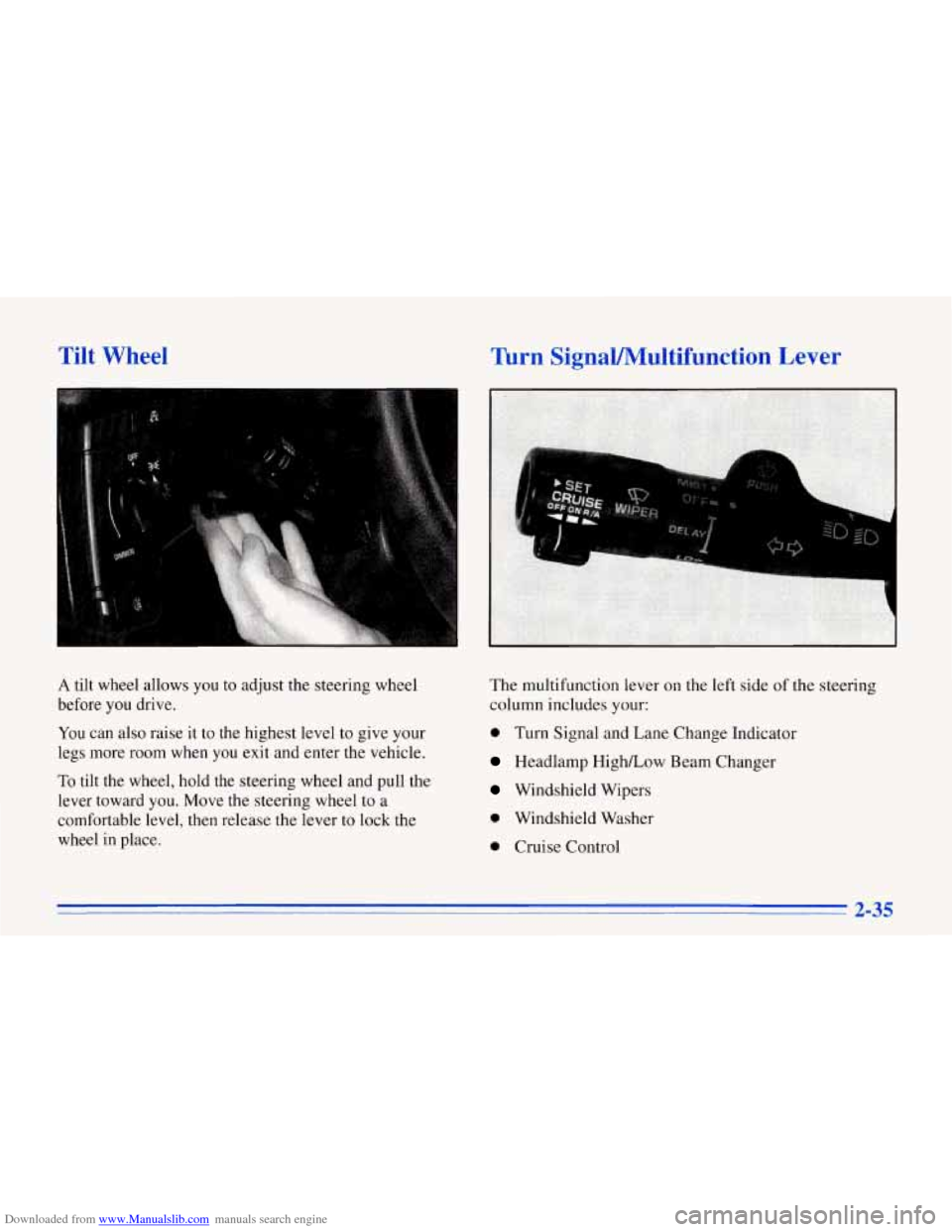
Downloaded from www.Manualslib.com manuals search engine Tilt Wheel
A tilt wheel allows you to adjust the steering wheel
before you drive.
You can also raise it to the highest level to give your
legs more
room when you exit and enter the vehicle,
To tilt the wheel, hold the steering wheel and pull the
lever toward you. Move the steering wheel to a
comfortable level, then release the lever to lock the
wheel in place.
Turn SignaYMultifunction Lever
The multifunction lever on the left side of the steering
column includes your:
0 Turn Signal and Lane Change Indicator
Headlamp HighLow Beam Changer
Windshield Wipers
0 Windshield Washer
0 Cruise Control
2-35
Page 79 of 386
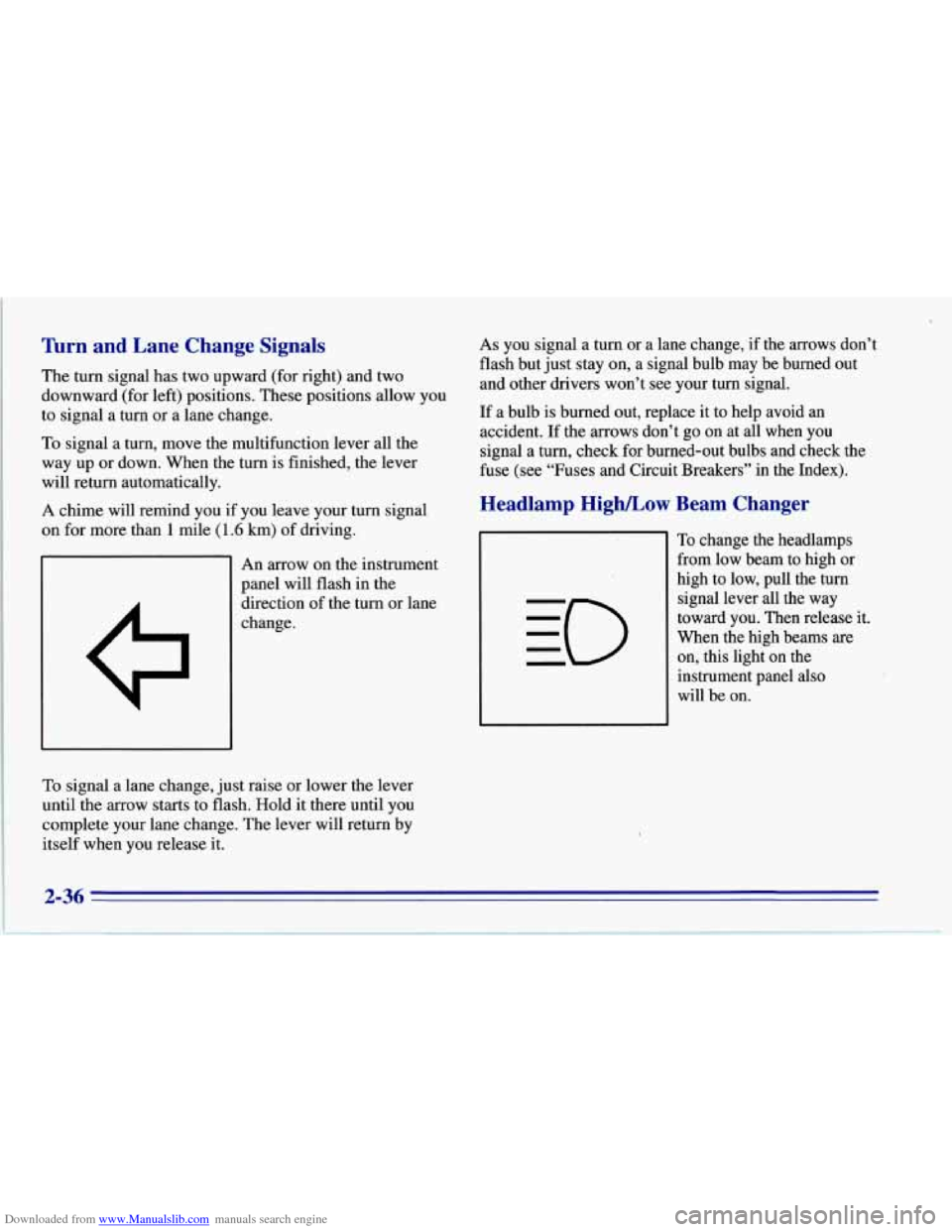
Downloaded from www.Manualslib.com manuals search engine nrn and Lane Change Signals
The turn signal has two upward (for right) and two
downward (for left) positions. These positions allow you
to signal a turn or a lane change.
To signal a turn, move the multifunction lever all the
way up or down. When the turn is finished,
the lever
will return automatically.
A chime will remind you if you leave your turn signal
on for more than
1 mile (1.6 km) of driving.
An arrow on the instrument
panel will flash in the
direction of the turn or lane
change.
To signal a lane change, just raise or lower the lever
until the
arrow starts to flash. Hold it there until you
complete your lane change. The lever will return by
itself when you release it.
As you signal a turn or a lane change, if the arrows don’t
flash but just stay on, a signal bulb may be burned out
and other drivers won’t see your turn signal.
If a bulb is burned out, replace it to help avoid an
accident.
If the arrows don’t go on at all when you
signal a turn, check for burned-out bulbs and check the
fuse (see “Fuses and Circuit Breakers” in the Index).
Headlamp High/Low Beam Changer
To change the headlamps
from low beam to high or
high to low, pull the turn
signal lever all the way
toward you. Then release it.
When the high beams
are
on, this light on the
instrument panel also
will be on.
Page 81 of 386
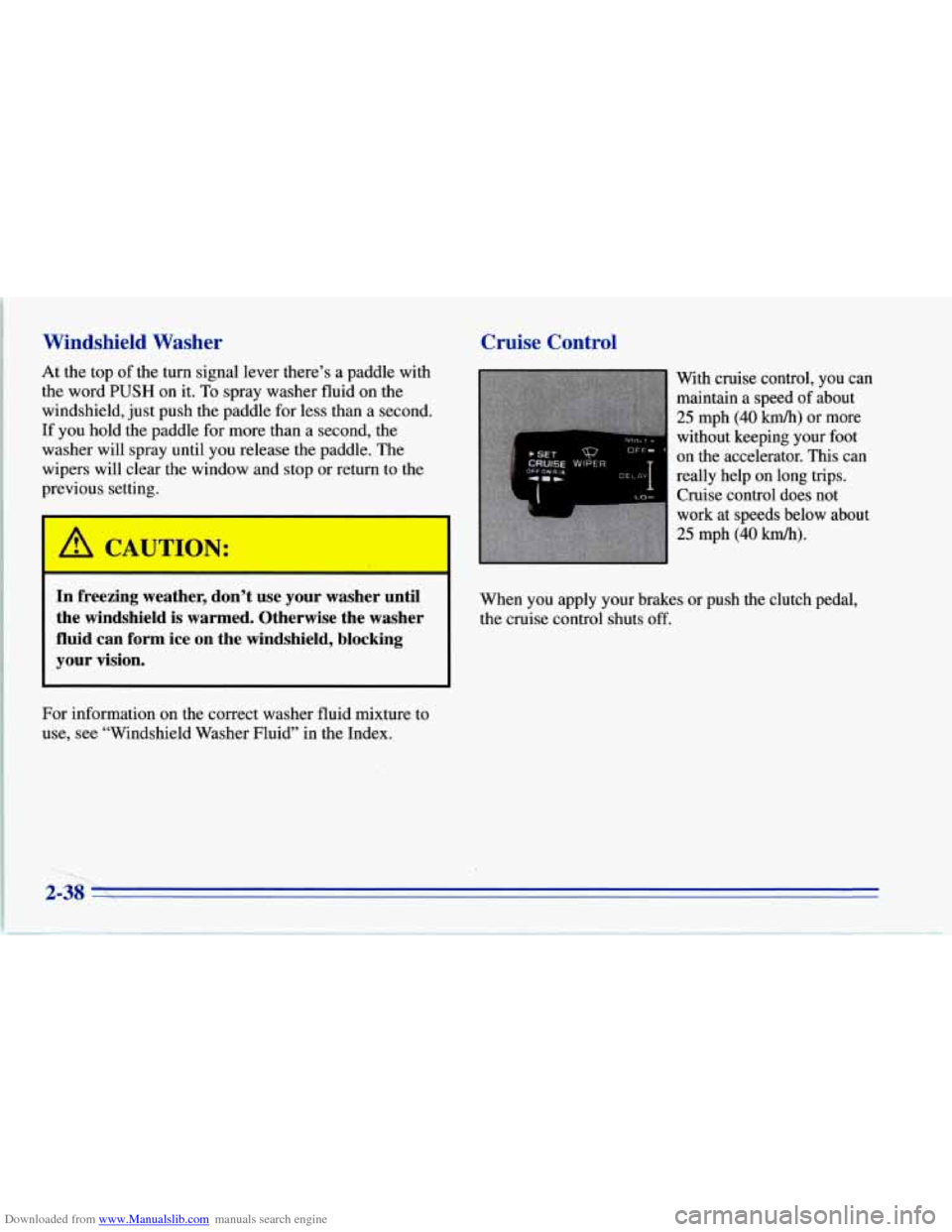
Downloaded from www.Manualslib.com manuals search engine Windshield Washer
At the top of the turn signal lever there’s a paddle with
the word
PUSH on it. To spray washer fluid on the
windshield, just push the paddle for less than a second.
If you hold the paddle for more than a second, the
washer will spray until you release the paddle. The
wipers will clear the window and stop
or return to the
previous setting.
c
In freezing weather, don’t use your washer until
the windshield is warmed. Otherwise the washer
fluid can form ice on the windshield, blocking
your vision.
For information on the correct washer fluid mixture to
use, see “Windshield Washer Fluid” in the Index.
Cruise Control
t LU-
With cruise control, you can
maintain a speed of about
25 mph (40 km/h) or more
without keeping your foot
on the accelerator. This can
really help on long trips.
Cruise control does not
work at speeds below about
25 mph (40 km/h).
When you apply your brakes or push the clutch pedal,
the cruise control shuts
off.
Page 87 of 386
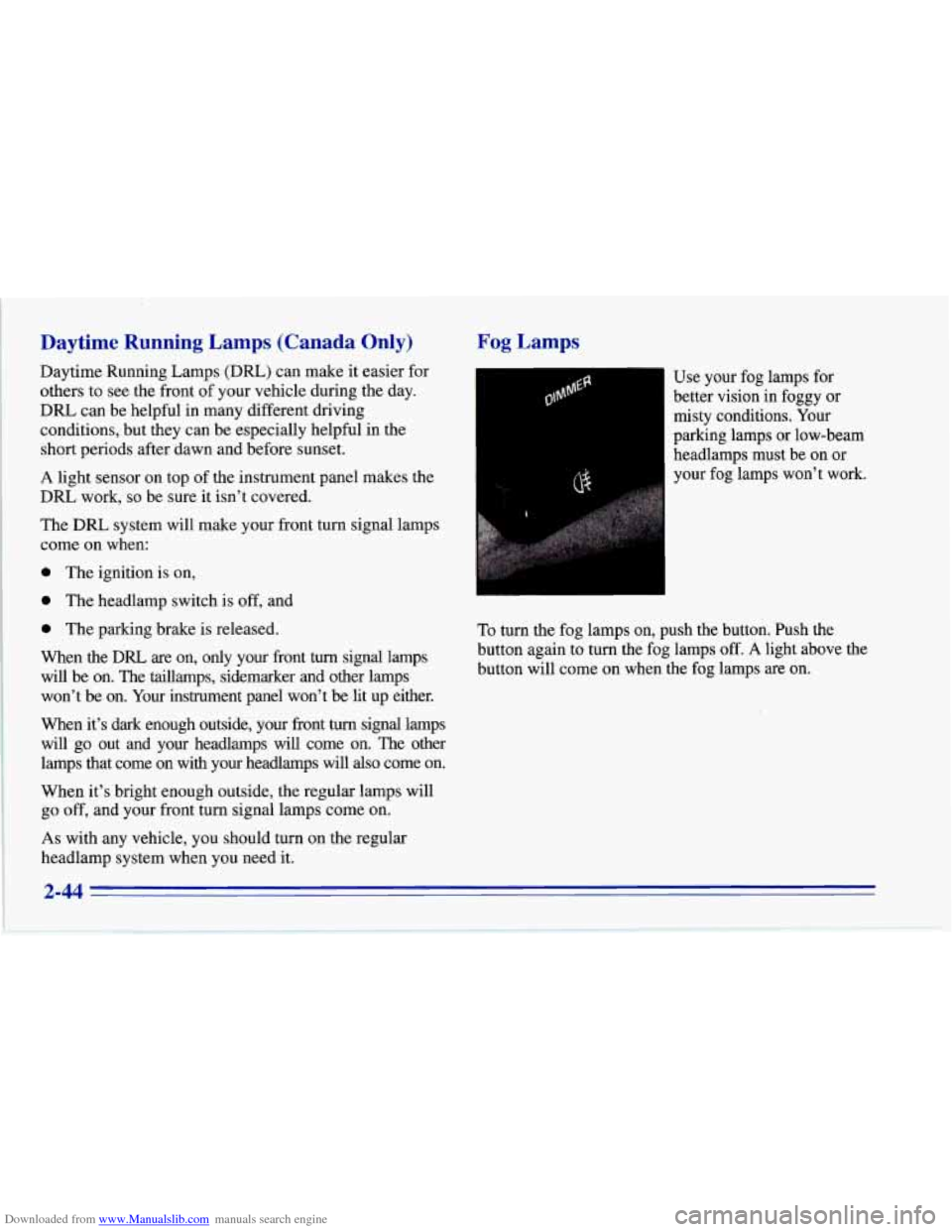
Downloaded from www.Manualslib.com manuals search engine Daytime Running Lamps (Canada Only)
Daytime Running Lamps (Dm) can make it easier for
others to see the front of your vehicle during the day.
DRL can be helpful in many different driving
conditions, but they can be especially helpful in the
short periods after dawn and before sunset.
A light sensor on top of the instrument panel makes the
DRL work,
so be sure it isn’t covered.
The DlU system will make your front turn signal lamps
come on when:
0 The ignition is on,
0 The headlamp switch is off, and
0 The parking brake is released.
When
the DRL are on, only your front turn signal lamps
will be on. The taillamps, sidemarker and other lamps won’t be on. Your instrument panel won’t
be lit up either.
When it’s dark enough outside, your front
turn signal lamps
will go out and your headlamps will come on. The other
lamps that come on with your headlamps will
also come on.
When it’s bright enough outside, the regular lamps will
go
off, and your front turn signal lamps come on.
As with any vehicle, you should turn on the regular
headlamp system when you need it.
Fog Lamps
I-1 Use your fog lamps for
better vision in foggy or
misty conditions. Your
parking lamps or low-beam
headlamps must be on or
your fog lamps won’t work.
To turn the fog lamps on, push the button. Push the
button again to turn the fog lamps
off. A light above the
button will come on when the fog lamps are on.
2-44
Page 128 of 386
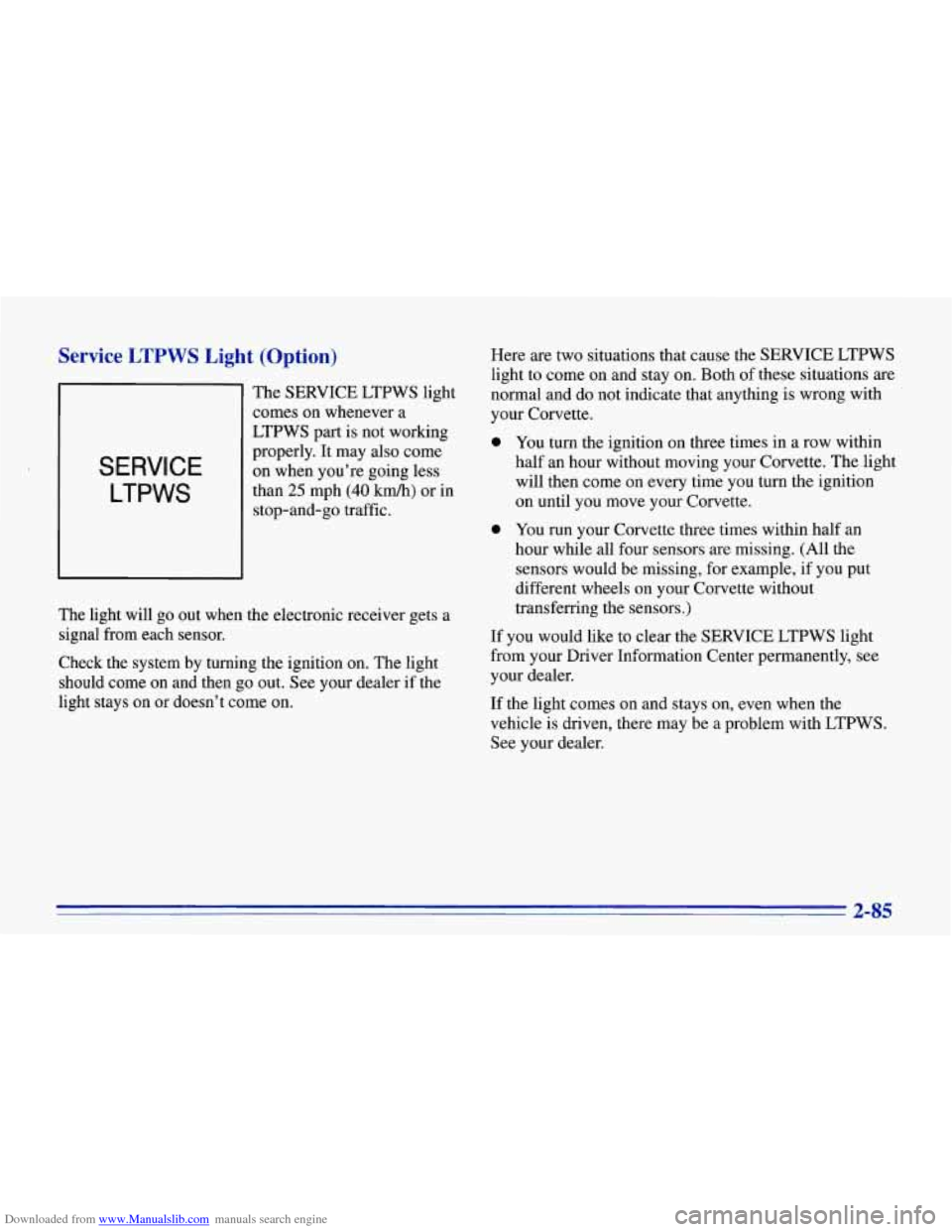
Downloaded from www.Manualslib.com manuals search engine Service LTPWS Light (Option)
SERVICE
LTPWS
The SERVICE LTPWS light
comes on whenever a
LTPWS part is not working
properly. It may also come
on when you’re going less
than
25 mph (40 kmh) or in
stop-and-go traffic.
The light will go out when the electronic receiver gets a
signal from each sensor.
Check the system by turning the ignition on. The light
should come on and then go out. See your dealer
if the
light stays on or doesn’t come on. Here
are two situations that cause the SERVICE LTPWS
light to come on and stay on.
Both of these situations are
normal and do not indicate that anything is wrong with
your Corvette.
0 You turn the ignition on three times in a row within
half an hour without moving your Corvette. The light
will then come on every time you turn the ignition
on until you move your Corvette.
0 You run your Corvette three times within half an
hour while all four sensors are missing. (All the
sensors would be missing, for example, if you put
different wheels on your Corvette without
transferring the sensors.)
If
you would like to clear the SERVICE LTPWS light
from your Driver Information Center permanently, see
your dealer.
If the light comes on and stays on, even when the
vehicle is driven, there may be a problem with LTPWS.
See your dealer.
2-85